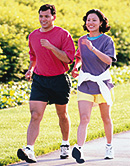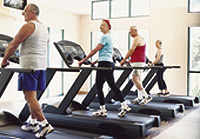|
WALKING YOUR WAY TO HEALTH
|

|
|
|
Walking by far is the easiest way of exercising that almost anyone can do. It has been the most popular fitness activity worldwide. Walking is the safest activity that increases the feeling of well being, is low impact, can be done anytime, at any place and in any weather hence is recommended by most physicians especially for chronic ailments like diabetes, arthritis, high blood pressure, obesity and also in pregnancy.
No special tools are required, only a good pair of padded shoes. Walking is an excellent fat burner and if done regularly, lowers weight, blood pressure, and cholesterol and increases bone mineral content. Technically speaking, walking is a reflex action and no conscious control is necessary. On the contrary, if attention is focused on any part, tension is likely to develop and the natural rhythm and coordination are disturbed.
Reflexes control not only the extension of the limbs but also the extension of both the supporting limbs and trunk in preventing the downward pull of gravity. Thus, in walking, as in all motions of the body, smooth coordinated movement requires properly functioning reflexes, normal flexibility of joints and optimum stability of the body as a whole and in weight bearing areas.
|
 |
 |
| Each individual has their own unique walking style. Although the basic movements are common, individual characteristics are present to such an extent that persons are often recognised by their gait |
|
Walking, in other words, is the forward motion of the trunk by means of backward thrust of the leg and foot. The trunk meets air resistance, which tends to push it backwards. By inclining the body forwards, the pull of gravity is utilised to balance this air resistance. When walking against a strong wind, the body should be inclined further and abdominal and anterior neck muscles contracted.
TECHNIQUE FOR A CORRECT WALK:
Head up: People generally walk with their heads down and chins tucked under. This results in a rounding or slouching of the shoulders and tension in the neck bones. Proper posture is to keep chin up, eyes straight ahead, spine and neck straight, bent forward a bit at the hip joint, but not over-stretched or tensed at any point.
Shoulders relaxed: Shoulders generally become round, creep up around the ears or collapse forwards. The proper way is to keep the chin straight and lifted; shoulders are thrown backwards and downwards opening up and lifting the chest.
Chest up: With out much strain on lower back, chest should remain lifted as if a string pulls it up at the breastbone. Take care not to force it too forwards.
Abdominal muscles sucked in: Abdominal area remains unprotected in front and on sides due to the absence of bony protection, hence muscles here should always be strong, contracted and pressed against the spine, while walking.
Knee motion: It is important for walkers who have knock-knees or fat thighs to prevent themselves from friction between the limbs; they must increase the lateral distance while walking. Otherwise slight flexion of knees at the time of foot contact followed by extension of the limb is fine.
Arm swing: A walker’s speed is analysed by the swing of the arms as the feet follow the arms. Arms should be at a 90-degree angle and moved forwards and backwards without over-stretching, parallel to the body and not sideways. Hands closed but not clenched.
Foot roll: A walker must land on the heels to hold the whole body weight, roll the weight through the middle part of the foot to the ball and toes. When the heel hits the ground the walkers’ toes should be pulled back towards the shin. A walker can increase speed by taking shorter, quicker steps and not by increasing the stride.
Duration of walk should be for 20 minutes first, preferably in mornings, gradually increasing the frequency, duration and distance.
Speed should be steadily increased in such a way that your pulse rate increases to almost double at your rest state at half time, (take your pulse count at the beginning) gradually reducing to resting level at full time. Follow the technique of warm up, peak and cool down.
It is very important to listen to your body while walking. If at any stage you feel breathless, dizzy or fatigued you should stop and rest, never try to achieve instant results by over-exerting your body. We have to condition our body (heart and lungs) for the overload we throw on it while exercising.
Each individual has their own unique walking style. Although the basic movements are common yet individual characteristics are present to such an extent that persons are often recognised by their gait.
Think of actors like Dev Anand and Rajesh Khanna, or a fresher in a college, their peculiar walking style could be because of wrong postures, over acting, lack of self-confidence, or simply being shy (ideally such postures should not be followed as they cause permanent and deranged body alignment.)
The other distinctions happen due to structural differences, including unusual body contours as in obesity, knock-knees, bow legs, giving atypical gait. Out of these, we can easily take care of overweight and for the rest do consult a doctor.
Walking this way will ensure that you remain in a maintained state of fitness without over exerting your body, mind remains relaxed and you are ready to take on the challenges of everyday
life.
--The Author is managing director of
Personal Point and an acclaimed fitness expert
|
|
|
|
|
|
|
|
June 2006
|
|

|
|
|
|